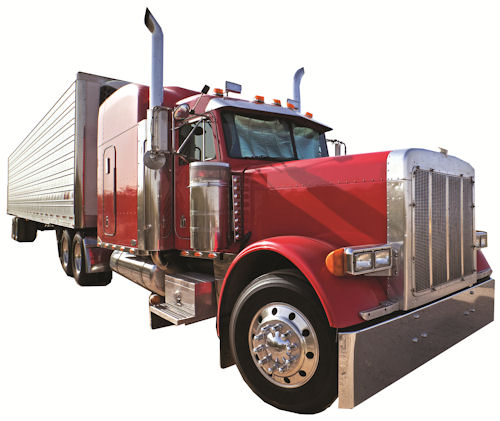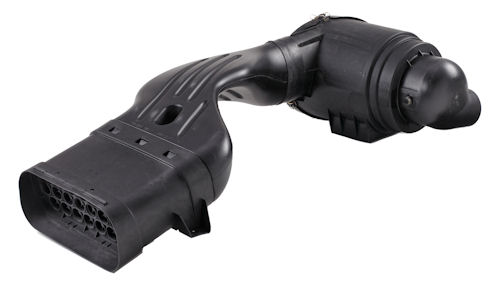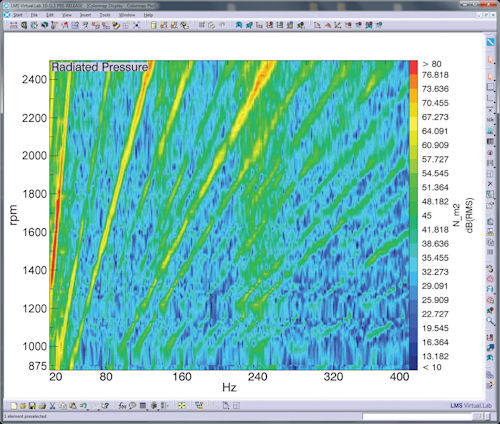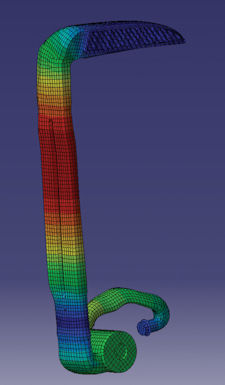Fast App: A Piece of Quiet
Donaldson hits noise reduction targets with LMS acoustic simulation, an ideal solution for the design changes caused by looming Euro 6 emission standards and tougher OEM requirements.
Latest News
December 14, 2012
By Stephen Glad
Business is changing at Donaldson, one of the world’s largest manufacturers of filters for trucks, buses, construction equipment and industrial machinery. In addition to orders for standard and custom air filters, a growing number of requests are for designing and building complete air intake systems for long-haul trucks. There’s a sense of urgency, because truck engines are being redesigned to meet deadlines for strict Euro 6 emission standards taking effect shortly.
This shift in research and development work from the original equipment manufacturer (OEM) to the supplier follows the trend in other segments where responsibility for system development is increasingly delegated to subcontractors. The result is a win-win situation, with OEMs better able to focus on total vehicle design—and capable suppliers gaining new business from their system-level know-how.
Mind-boggling Constraints
As Donaldson engineers can attest, landing these major contracts is no simple matter. Whereas filter orders are based mostly on specified size and materials, the air intake system must be developed around broad system requirements, such as filtered air quality and temperature, air-handling volume capacity and cab noise. Teams must design and piece together a whole assembly of parts, including intake nozzle, air-handling ducts, support brackets, filter housings and rubber bellows.
Complicating the task are packaging constraints in which the ducts must snake their way around parts mandated by Euro 6, including the selective catalytic reduction (SCR) and exhaust gas recirculation (EGR) units that hog up available space. Teams must also determine the best position for the intake nozzle—at the top or rear of the cab, or near the nose of the truck. This is a critical factor for air quality and temperature, and therefore engine efficiency.
Truck Cabs as Quiet as Cars
One of the most challenging aspects is to ensure that the air intake system will not contribute excessively to either the cab noise or pass-by noise levels of the vehicle. In practice, this means keeping its contribution 10dB lower than the vehicle target sound pressure level. For example, if a vehicle has a target of 70dB for the total cab sound pressure level at cruising speed (about 62 mph), the target contribution sound pressure level of the air intake system should be below 60dB.
 |
| Cab acoustics affect driver fatigue, safety and productivity, so truck manufacturers put noise reduction high on their list of design requirements. |
“Cab acoustics affect driver fatigue, safety and productivity, especially on long-haul trips of a week or more. So truck manufacturers put noise reduction high on their list of design requirements,” explains Gert Proost, engineering manager for on-road vehicle filtration at Donaldson’s European development center in Leuven, Belgium. “Meeting interior and pass-by noise targets using physical mock-ups and trial-and-error testing is just too expensive, time-consuming and uncertain, given the huge number of interacting variables.”
Gaining Expertise
The answer, Proost notes, is acoustic simulation that enables engineers to evaluate sound levels and possible noise reduction fixes quickly and easily using computer models. Rather than outsourcing such work to other facilities and putting up with long waits in shuffling project iterations back and forth, the Leuven group decided to bring acoustic simulation in-house.
 |
| Air intakes mounted at the front of trucks have complex geometries to fit into available space around the engine, pollution control units and other equipment. |
“Doing acoustic simulation ourselves is highly efficient,” Proost says. “We can see how sound characteristics vary with slight changes in components, materials and geometries. This gives our engineers tremendous insight into the acoustic behavior of the entire system.”
Donaldson selected LMS Virtual.Lab Acoustics as the acoustics simulation software of choice. The decision was based on reputation and widespread use of the software in the automotive industry, the technical assistance available from LMS, and the modeling capabilities of the software in handling airborne as well as structure-born noise and vibrations.
Donaldson is currently using the simulation software to develop an air intake system for a major European truck manufacturer, aiming to have one of the quietest long-range truck cabs on the market. Other vehicle manufacturers have also approached Donaldson, requesting quotes for system-level designs.
 |
| Waterfall diagram of spectral data created in LMS Virtual.Lab Acoustics helps engineers ensure engine pressure pulsations from the turbocharger are sufficiently attenuated by the air intake system. |
“Clearly, ongoing work with the initial truck project will enable us to employ the same approach for future contracts in developing complete air intake systems that produce minimal cab noise,” Proost says. “LMS Engineering Services has been with us every step of the way, with technical assistance to validate models and fine-tune our overall approach.”
Finding and Fixing Unacceptable Noise
As the first simulation step, Donaldson engineers represent the air intake system with a boundary element method (BEM) model, a technology particularly well suited to studying airborne noise because the method does not require engineers to go through the tedious task of modeling interior air volumes. This model is used to determine standing-wave frequencies produced in various duct sections. Structure-born vibrations are studied using a coupled finite element method (FEM) analysis to ensure that standing waves do not excite ducts and other parts of the system to vibrate at resonance.
 |
| LMS Virtual.Lab Acoustics model of a roof-mounted air intake system. Donaldson engineers study its standing waves to avoid exciting resonant frequencies vibration modes inside the truck cabin. |
Next, engineers compute the transfer function of audible noise transmitted from the nozzle to the driver’s ear. For this computation, they set up a low-frequency sound source in the cab and measure the corresponding frequency response at the nozzle with a LMS Test.Lab SCADAS Mobile signal data acquisition and analysis system—chosen for its portability, speed in gathering data and seamless compatibility with LMS Virtual.Lab. This measurement enables engineers to back-calculate the noise transfer function (NTF), or the ability of the air to transfer sound energy from the nozzle to the cab.
Finally, the NTF is multiplied by the combined airborne and structure-borne vibration energy to determine total interior cab noise. The result is a color-coded 3D plot of sound energy distribution in the cab interior to identify any hot spots of sound power density. Engineers can then quickly modify the intake design with resonators, stiffeners and other modifications to eliminate resonance. They see the results of these modifications almost immediately. A few rounds of these changes are generally all it takes to optimize cab noise levels.
Near the end of development, Donaldson engineers use a LMS SCADAS Vibco vibration control system for accelerated fatigue-life shaker tests. This demonstrates in just a day or two the ability of the air intake to withstand the vibration it will likely experience over a lifetime on the road.
“Using a predictive process based on LMS Virtual.Lab Acoustics, our engineering teams can perform studies in a few hours that would take months, or even years—and cost tens of thousands of euros in physical mock-ups,” Proost concludes. “This approach gives us the capabilities we need to develop complete air intake systems optimized to meet rigorous noise limits. Our cutting-edge acoustics know-how has certainly become a critical competitive advantage and helps us gain research and development contracts up the supply chain for vehicle manufacturers around the world.”
Stephen Glad is a writer with Structured Information, Boston. Send e-mail about this article to [email protected].
Subscribe to our FREE magazine, FREE email newsletters or both!
Latest News
About the Author
DE’s editors contribute news and new product announcements to Digital Engineering.
Press releases may be sent to them via [email protected].






